Vienna Travel Guide
Known as both the 'city of music' and the 'city of dreams', Vienna is as romantic as it sounds, and remains one of Europe's most alluring capital cities for culture vultures. Vienna is an ornate and stately city where the strains of the great classical composers who lived and worked here seem to seep from the stones along with old world charm. This is why a holiday in Vienna is enough to inspire anyone to hum the 'Blue Danube' and waltz around the sights before they head for the woods to end the day in the cosy atmosphere of a traditional wine tavern. Speaking of taverns, Vienna boasts a booming bar and restaurant scene to complement its many historic and cultural offerings. The city is also home to some wonderful markets that provide great shopping opportunities.
The whole family can find fun and fascination on a Vienna holiday, as there are plenty of fun activities and diversions, from the performing horses of the Spanish Riding School and the thrills of the Prater amusement park to the opulence of the Schonnbrun Palace.
Best time to visit Vienna
The best time to travel to Vienna is in spring (April and May) and autumn (September and October), when the weather is beautiful and the peak tourist season is beginning and ending. Summer, between June and August, is the most popular tourist season and sees hordes of holidaymakers descend on Vienna.
What to see in Vienna
-Enjoy lovely views of the city from the Giant Wheel in the Prater.
-Marvel at the world-famous art collection of The Albertina.
-See the Gothic masterpiece that is St Stephen's Cathedral.
-Watch the prancing Lipizzaner horses at the Spanish Riding School.
What to do in Vienna
-Visit the beautiful Belvedere and its rewarding museums.
-Get to grips with the world of Sigmund Freud at Vienna's Freud Museum.
-Explore the world of the Hapsburgs at the Hofburg Palace and the Schonbrunn Palace.
-Take a tour or catch a show at the Vienna State Opera.
Beyond Vienna
Vienna is situated in northeastern Austria and even the Austrian Alps, in the southwest, are within easy reach of the capital. The popular city of Salzburg is less than three hours away from Vienna by car, and Innsbruck, the gateway to the Alps, is four and a half hours away by car.
Getting there
Austria's main air travel hub, Vienna International Airport is located 11 miles (18km) southeast of Vienna. Trains also wend their way to Vienna from a number of European cities.
Did you know?
-The snow globe was invented, by accident, in Vienna, and these whimsical globes make popular souvenirs.
-Vienna contains good vineyards within its city limits, producing glorious wine.
-More than 200 balls take place in Vienna every year.
Things to do in Vienna
Vienna has hundreds of beautiful historic attractions and cultural treasures to explore, from stunning Baroque palaces to the world-famous 'flying' Lipizzaner stallions. The Imperial Palace is home to the Schatzkammer, which is the greatest treasury in the world and holds treasure from as far back as the Holy Roman Empire. The Fine Arts Museum across from the palace houses many of the art collections gathered by the Habsburgs and is sumptuously decorated with marble, gold leaf and stucco ornaments.
Another of Vienna's most recognisable attractions is the giant Ferris wheel called the Riesenrad, which is located in a large wooded park. And for those partial to song and dance, the Vienna State Opera performs a vast repertoire of operas, operettas and ballets.
Vienna has been home to some of classical music's greatest composers, and visitors can easily spend a day touring the residences where Beethoven wrote his 5th Symphony, Haydn composed The Creation, and Strauss wrote the Blue Danube Waltz. No musical tour would be complete without seeing the Mozart Memorial.
Most of the city's attractions are encompassed by the Ringstrasse, which makes them easily accessible, especially on foot or by bike. The Vienna Card is handy for reduced fares when using public transport in the city. With so many beautiful areas, cultural attractions and historic sites, Vienna is definitely a city to spend plenty of time in.
Hofburg
The Hofburg Palace was the home of the Habsburg dynasty for 600 years, its fortifications continually expanded since its construction in the 13th century. As well as housing the president's offices, the palace now encompasses 22 separate museums, the National Library, a 14th-century Augustinian church, the famous Spanish Riding School and the Royal Chapel. The most popular museums are the Kaiserappartements, the Sisi Museum and the Imperial Silver Collection. Situated in the Hofburg Palace, the 14th-century royal library is among the oldest and finest in the world. Its some six million items include papyri, manuscripts, ancient books, maps, portraits, music and photographs. The Grand Hall is a palatial room topped by a dome, designed in the Baroque style and decorated with statues and exquisite frescoes.
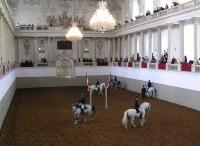
Spanish Riding School
The Spanish Riding School of Vienna is one of the oldest surviving riding schools in the world, where classic dressage is still practised in its purest form. This institute was founded in 1572 and named for the Lipizzaner horses, which are of Spanish origin. Since the collapse of the Danube Monarchy in 1920, the horses have been bred at the Federal Stud in Styria. The horses perform their tricks in the Winter Riding School, commissioned by Emperor Karl VI. Performances take place between February and June, and September and December. With shows booked up months in advance, the easiest way to see the horses is during training sessions. Situated in the stables is the Lipizzaner Museum, which displays the history of the school.
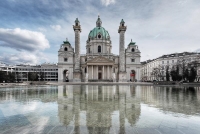
Karlskirche
Karlskirche is the most outstanding Baroque church in the city and its 236-foot (72m) high dome flanked by two columns forms an iconic landmark of the Viennese skyline. The church was commissioned by Emperor Charles VI after a great plague swept through Vienna in 1713, and is dedicated to the revered healer Saint Charles Borromeo. The lavishly decorated interior includes frescoes and visitors can get a closer look by taking the elevator to the roof, which is included in the entry fee. Although the lift carries visitors most of the way up, there are some steps to be climbed to get to the very top of the dome.
Schonbrunn Palace
The magnificent Schonbrunn Palace was used as the summer residence of the Habsburgs, who were once among the most prominent royal houses of Europe, from the 18th century onwards. Set among superb gardens, this vast symmetrical structure is everything visitors would imagine an imperial palace to be. A tour of the palace offers visitors the chance to view the superb assortment of Baroque and Rococo State Rooms and to admire the famous ceiling frescoes of the Great Gallery and the Hall of Mirrors where Mozart once played. The vast gardens are popular with locals and tourists alike, and include a zoo, a maze, the Privy garden and the Gloriette with a viewing terrace. Also within the grounds, the Orangery hosts classical concerts during the summer season.
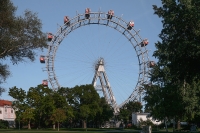
Giant Wheel
One of Vienna's most recognisable landmarks, the Giant Wheel is located in a large wooded park and playground known as the Prater. It was built in 1897 by an English engineering firm and is the only one of its era still standing. By contrast, the Ferris wheels in Chicago, London, Blackpool, and Paris have long since been destroyed. The wheel's 15 gondolas take 20 minutes to manoeuvre around and offer magnificent panoramic views of the city. Cautious visitors need not worry about the age of the Giant Wheel as it has been very well maintained over the decades! This is a fun attraction for the whole family and will delight the children.
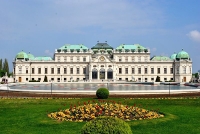
Belvedere
The Belvedere is a world-renowned museum, housing Vienna's most prestigious art galleries displaying excellent examples of Austrian works from the Middle Ages to the present day. It boasts an unrivalled collection of paintings by Klimt, as well as famous pieces by Schiele, Renoir and Monet. The complex consists of two splendid 18th-century Rococo mansions, facing one another across sweeping grounds offering views over the city. The Medieval and Baroque works are presented in the Lower Palace where many rooms have been preserved in their original state.
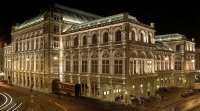
Vienna State Opera
The Vienna State Opera performs a repertoire of nearly one hundred operas, operettas and ballets every day from September to June. The opera house was founded in the early 18th century but rebuilt in 1945, and is today a romantic and regal setting in which to enjoy the performances. As seating tickets are not easily available, an alternative is to buy standing tickets. The State Opera collaborates closely with the Vienna Philharmonic Orchestra and their famous New Year concert requires advance bookings of up to one year. The building is beautiful and of interest in itself, even if visitors are unable to catch a show.
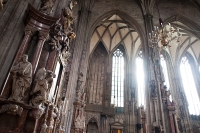
St Stephen’s Cathedral
The cathedral is one of the greatest Gothic structures in Europe, with its massive south tower standing at 445 feet (136m) tall. A dominant feature on the Vienna skyline, its 343 steps can be climbed for fantastic views. It has been in a state of continual preservation and repair since its original construction in the 12th century due to fire, sieges and bombardment. The cathedral is built of limestone and has an ornately patterned and richly coloured roof covered by glazed tiles. The interior is rich in wood carvings, sculptures and paintings and has numerous chapels, altars and catacombs. Wolfgang Amadeus Mozart was married here, had children baptised here, and his funeral was held in the Chapel of the Cross.
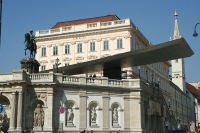
The Albertina
Formerly the residence of Habsburg archdukes and archduchesses, the Albertina houses one of the largest and greatest graphic art collections in the world, which includes drawings, old master prints and modern works. The museum explores the development of graphic arts since the 14th century and there are more than 60,000 works on show. Artists featured include Leonardo da Vinci, Michaelangelo, Manet, Picasso and Cezanne. The Albertina is also one of the most beautiful examples of classical architecture in the world. There is a pleasant cafe for refreshments, while the museum is beautifully conceived, with each room decorated to complement the art on display.
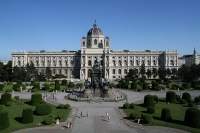
Museum of Fine Arts (Kunsthistorisches Museum)
The Fine Arts Museum is one of the world's foremost museums of fine and decorative arts, and houses many of the collections gathered by the Habsburgs, who were among the chief dynasties of Europe from the 15th to the 20th century. The magnificent building is crowned with a 197 foot (60m) high dome, while the inside is sumptuously decorated with marble, gold leaf and stucco ornaments, a fitting home to the formidable artistic treasures collected over the centuries. The collections range from Ancient Egyptian, Greek and Roman relics to medieval, Renaissance and Baroque paintings. The museum faces the Natural History Museum across the Maria-Theresian Platz, which has an identical exterior.
Haus der Musik
The House of Music is an interactive discovery museum devoted to music and is located in the former Palace of Archduke Charles. Four floors take visitors past the music and memorabilia of the great composers who lived in Vienna, such as Mozart, Beethoven, Brahms and Schubert, while also allowing visitors to discover today's top musicians and explore the future of music on computers. Visitors can conduct an orchestra, listen to what an unborn child hears in the womb or paint a musical picture. The museum is critically acclaimed for its innovative design and allowing visitors to experience music using the senses of sight, sound, touch and hearing.
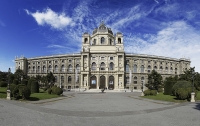
Natural History Museum
The impressive Natural History Museum is situated within a Renaissance Revival building identical from the outside to the Fine Arts Museum opposite. It is the third largest natural history museum in the world and has some of the oldest exhibits, including early Stone Age artefacts. Visitors can travel through the planet's history, ranging from the diversity of nature to the origins of culture. Guided tours, lectures and workshops on a variety of interesting themes are offered regularly at the museum.
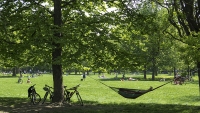
Wiener Prater
This large public park is a great place for families to enjoy a day in the sunshine. Visitors can stroll along the Hauptallee, where chestnut trees line the way, or visit the Planetarium and the Prater Museum, both located inside the park. The Wiener Prater also has a small amusement park with a Ferris Wheel, a rollercoaster and a number of other fun rides and diversions, as well as food stalls and games booths. There is plenty of open space here for kids to run around and the cheesy, innocent fun of the amusement park is enjoyable for the whole family. Entrance to the park is free but individual rides must be paid for.
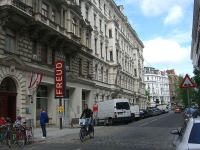
Freud Museum
One of Vienna's most famous sons, Dr Sigmund Freud revolutionised the study of psychology with his ideas. Though many of his theories once wildly popular have been discredited, the term 'Freudian slip' and other ideas still pervade society today. The Freud Museum in Vienna houses a number of antiques and mementos of the doctor inside the offices in which he practised from 1891 to 1938. Guided tours are available and the museum has a gift shop offering photos and other memorabilia, as well as books written by Freud. This attraction will be very exciting for those interested in Freud and his work, and it will provide a good introduction for those who are unfamiliar.
Things to do with kids in Vienna
Boasting wonderful scenery and amazing outdoor activities the whole family can enjoy, Vienna is a great place for children on holiday. From walks to bike rides and hikes, there is plenty to see and do in Vienna that will keep active children entertained for hours on end.
Visitors can take a walk through the breathtaking Vienna Woods, or pack a picnic and head out for the day to the Wiener Prater, where the kids will have ample space to run around and let off some steam in the amusement park with its famous Ferris wheel. When the novelty wears off, they can head to the Planetarium, which is also located here.
Kids will love watching the world famous Lipizzaner stallions as they 'fly' through the air. But parents should note that the Lipizzaner shows must be booked long in advance, and often the training sessions, which are open to the public, are the best option for seeing the incredible horses.
When the weather is cold and wet, it's worth exploring BOGI Park, Austria's largest indoor playground. Children will be beside themselves with the choices here and the opportunity to meet other kids. And if the children aren't scared of clowns, the Circus and Clown Museum is also an option. Minopolis, a mini children's city where kids can try their hand at various professions, is another great favourite.

Spanish Riding School
The Spanish Riding School of Vienna is one of the oldest surviving riding schools in the world, where classic dressage is still practised in its purest form. This institute was founded in 1572 and named for the Lipizzaner horses, which are of Spanish origin. Since the collapse of the Danube Monarchy in 1920, the horses have been bred at the Federal Stud in Styria. The horses perform their tricks in the Winter Riding School, commissioned by Emperor Karl VI. Performances take place between February and June, and September and December. With shows booked up months in advance, the easiest way to see the horses is during training sessions. Situated in the stables is the Lipizzaner Museum, which displays the history of the school.
Haus der Musik
The House of Music is an interactive discovery museum devoted to music and is located in the former Palace of Archduke Charles. Four floors take visitors past the music and memorabilia of the great composers who lived in Vienna, such as Mozart, Beethoven, Brahms and Schubert, while also allowing visitors to discover today's top musicians and explore the future of music on computers. Visitors can conduct an orchestra, listen to what an unborn child hears in the womb or paint a musical picture. The museum is critically acclaimed for its innovative design and allowing visitors to experience music using the senses of sight, sound, touch and hearing.

Wiener Prater
This large public park is a great place for families to enjoy a day in the sunshine. Visitors can stroll along the Hauptallee, where chestnut trees line the way, or visit the Planetarium and the Prater Museum, both located inside the park. The Wiener Prater also has a small amusement park with a Ferris Wheel, a rollercoaster and a number of other fun rides and diversions, as well as food stalls and games booths. There is plenty of open space here for kids to run around and the cheesy, innocent fun of the amusement park is enjoyable for the whole family. Entrance to the park is free but individual rides must be paid for.
Eating Out
Austria's cuisine is a rich stew of historic, international influences. Many local chefs combine traditional Viennese dishes with the principles of nouvelle cuisine, creating Neue Wiener Küche (New Viennese cuisine).
Vienna is well known for its pastries, with other famous dishes including Wiener Schnitzel, Gulasch, and (boiled beef with apple and horseradish sauce). The best desserts to try are Sachertorte cake and (apple strudel). Don't be surprised if you are offered a shot of Schnapps after a meal! Lunch is traditionally the biggest meal of the day for Austrians, but this has changed over the years and most working people now eat their most important meal in the evening.
Vienna's bar and restaurant scene is currently booming, and great eateries for all budgets can be found. The best districts for eating out in Vienna include the Museum Quarter, which is full of outdoor cafes and some of the city's most renowned restaurants; the Spittelberg district, which boasts many bars and restaurants, as well as some interesting shops; the Naschmarkt and trendy Freihaus district, which are wonderful after dark; and the area around Gumpendorter Strasse, which is a new hotspot for popular restaurants.
Shopping
Vienna's most trendy shopping strip is the Mariahilfer Strasse, where hundreds of stores offer fashion, jewellery and accessories. In the city centre, there are a variety of jewellery stores and boutiques. Local specialities include Augarten porcelain, ceramics, handmade dolls, wrought-iron work and leather goods.
Agent Provocateur is located at 14 Tuchlauben, the first outlet of the cult London underwear label in central Europe. Kiehl's started out 150 years ago in a small apothecary and is now a chic cosmetics brand, with its flagship store in Tuchlauben in Vienna. For upmarket threads by leading designers, travellers should visit Firis on Bauernmarkt.
On Freisingergasse, Schokoladekonig makes handmade chocolate treats, while Boehle stocks superior wines and traditional specialities (deli snacks) in Wollzeile. For spices and cookery books, shoppers should try Babette's on Schleifmuhlgasse. Karlsplatz holds the Naschmarkt food market during the week and a flea market on Saturdays. Travellers should go to City Hall Square in December for the Christmas market.
The Kaufhaus Schiepek department store at Teinfaltstrase is definitely worth visiting for its variety of outlets. For the more eccentric, Carnaby sells vintage fashion and accessories on Neubaugasse, while magicians' accessories and gimmicks can be found at Zauberklingl on Führichgasse.
Austria's VAT is refundable with a valid receipt. Tourists can also take advantage of tax-free shopping where advertised. With something for everyone in store, Vienna is the place to break in those shopping shoes.
Nightlife
Laidback Vienna does have a nightlife, it's just not as frantic as that found in many other European capitals. The city's best bars tend to be in the (inner city), with a range of venues spanning Irish pubs to designer bars, as well as time-capsule spots from before World War I, with Adolf Loos' American Bar is a prime example. The Copa Cagrana's beach-styled bars serve glorious fruit cocktails.
As far as nightclubs go, the Gurtel area is home to the Rhiz, which attracts electronica fans and there are a couple of clubs near Nussdorfer Strasse that offer house music. For the more culturally inclined, many Viennese museums stay open late, with the Albertina and the House of Music being classic choices. Of course, Vienna is a musical city, and operas, ballets, and classical concerts are probably the best options for after dark entertainment.
Getting Around
Vienna boasts one of the finest public transport systems in Europe. It is safe and easy to use, consisting of punctual buses and trams, a fast U-Bahn (underground), and S-Bahn (railway). Most operate from about 6am to midnight; buses stop earlier but there are night buses on weekends covering the major routes.
The U-Bahn is the fastest way to get around the city, while the S-Bahn is the fastest way to get to the airport. The tram network is one of the largest worldwide and is the next best way of getting about, with the added advantage of being a good way to see the city, although some lines don't operate on weekends. Buses are useful in the inner city where there are no trams.
Fares are standard for all forms of public transport, and once validated will allow one journey including transfers in the same direction. Travel passes are available: the Vienna Card is valid for three days, allows unlimited travel on public transport, and offers discounts at many attractions, shops and restaurants.
Taxis are plentiful, reliable and metered, but have a list of surcharges and are among the most expensive in Europe; Lyft and Uber are also options. The most romantic, if expensive, way to get about is by horse-drawn carriage, or fiaker. A car is generally a burden in Vienna, but can be useful for trips outside the city.
Vienna Climate and Weather
Vienna has a temperate continental climate, with warm, sunny summers, and cold winters. The average temperature range in winter (December to February) is between 23F and 34F (-5C to 2C), while in summer (June to August), temperatures range between 75F and 91F (24C and 33C). Thunderstorms occur frequently in summer and snowfall is common in winter. Spring, autumn, and the beginning of summer are perhaps the best times to travel to Vienna.
Austria travel info
Electricity
Electrical current is 230 volts, 50Hz. European two-pin plugs are standard.
Language
The official language in Austria is German.
Money
The unit of currency is the euro (EUR). Currency can be exchanged at banks and bureaux de change available in all towns, but it may be easier to use the ATMs. Banks are closed on Saturdays and Sundays, but bureaux de change at airports and major city rail terminals are open seven days a week. Most credit and debit cards are widely accepted though some small hotels and restaurants may only accept cash.
Tipping
A 10 to 15 percent service charge is normally added to hotel and restaurant bills in Austria, but it is customary to leave another five percent if satisfied with the service. Sometimes, patrons can round off the bill. Bartenders usually expect a rounded-up tip. It is common to give the money to the waiter rather than leave it on the table, but leaving small change for other service personnel is fine. Taxi drivers expect a 10 percent tip.
Health
All eligible travellers should be up to date with their COVID-19 vaccines. Water and food are safe and medical facilities are excellent; citizens of EU countries can get free emergency medical treatment at public hospitals in Austria on production of a European Health Insurance Card (EHIC). After Brexit, the Global Health Insurance Card (GHIC) replaced the European Health Insurance Card (EHIC) for UK citizens. The GHIC allows UK citizens access to state healthcare during visits to the EU. The GHIC is not valid in Norway, Iceland, Liechtenstein or Switzerland, nor is it an alternative to travel insurance.
Safety
Travel to Austria is generally trouble-free. However, visitors are advised to take sensible safety precautions to avoid petty theft, particularly in larger cities.
Local customs
The most common and courteous greeting is the handshake, which is normal regardless of age and gender. Many Austrians value their physical and personal privacy when among strangers, so it's best to respect their personal space. A good conversation topic is the country's regional diversity, as Austrians enjoy talking about their home region. It is compulsory that vehicles are driven with their lights on throughout the year; smoking is not allowed in many public places.
Doing business
Business protocol is very important in Austria and business is formal, structured and conservative, more so than in many other Western European countries. All correspondence should be formal. Dress is conservative yet elegant; Austrians take great pride in their appearance and a good quality, well-fitting suit for men and women should be worn to make a good first impression. Austrians are also very title-conscious, and it's best to always use last names with a preceding title such as Herr (Mr), Frau (Mrs) or Fraulein (Miss), along with their professional or academic title where applicable (e.g. Herr Professor Kaufmann). It is vital to arrive punctually for meetings and to be thoroughly prepared, as meetings are brief and to the point. Foreigners should be prepared to engage in preliminary small talk, including a knowledge of current affairs, before getting down to business. English is widely spoken in business, but printed literature should be in German if possible. Offices open at 8am and close promptly at 5pm, Monday to Friday.
Duty free
Travellers from non-EU countries over 17 years are allowed to bring in the following items without paying customs duty: 200 cigarettes, or 100 cigarillos, or 50 cigars, or 250g of smoking tobacco, or a proportional mix of these products; 4 litres non-sparkling wine, or one litre of spirits with alcohol content more than 22 percent, or two litres of alcohol volume less than 22 percent; 60ml perfume and 250ml eau de toilette; and other goods to a total value of €430. Restricted items include pornographic material and fresh foodstuffs such as meat and dairy products. Travellers must have a European Firearms Pass if travelling with firearms.
Communications
The international access code for Austria is +43. Hotels, cafes and restaurants offering free WiFi are widely available. As international roaming costs can be high, purchasing a local prepaid SIM card can be a cheaper option.
Passport & Visa
The borderless region known as the Schengen area includes the following countries: Austria, Belgium, Czech Republic, Denmark, Estonia, Finland, France, Germany, Greece, Hungary, Iceland, Italy, Latvia, Lithuania, Luxembourg, Malta, The Netherlands, Norway, Poland, Portugal, Slovakia, Slovenia, Spain, and Sweden. All these countries issue a standard Schengen visa that has a multiple entry option that allows the holder to travel freely within the borders of all. For most nationalities, passports are required to be valid for three months beyond period of travel. It's recommend that passports be valid for six months from the departure date.
Entry requirements
US passport holders require a passport valid for three months beyond period of intended stay, but a visa is not needed for a stay of up to 90 days.
British passports require at least three months validity beyond the period of intended stay in Austria. No visa is required for stays of up to 90 days.
Canadians require a passport valid for three months beyond intended period of stay, but no visa is needed for a stay of up to 90 days.
Australians require a passport valid for three months beyond period of intended stay, but no visa is needed for a stay of up to 90 days.
South African nationals require a passport valid for three months beyond the period of intended stay and a visa.
Irish nationals require a passport but no visa is needed for travel to Austria.
New Zealanders require a passport valid for three months beyond period of intended stay, but a visa is not needed for a stay of up to 90 days.
Useful contacts
Austrian National Tourist Office, Vienna: +43 (0)1 588 660 or www.austria.info
133 (police), 140 (mountain rescue), 144 (ambulance)Embassies / consulates in other countries
Austrian Embassy, Washington DC, United States: +1 202 895 6700.
Austrian Embassy, London, United Kingdom: +44 (0)20 7344 3250.
Austrian Embassy, Ottawa, Canada: +1 613 789 1444.
Austrian Embassy, Canberra, Australia: +61 (0)2 6295 1533.
Austrian Embassy, Pretoria, South Africa: +27 (0)12 452 9155.
Austrian Embassy, Dublin, Ireland: +353 (0)1 269 4577.
Consulate of Austria, Wellington, New Zealand: +64 (0)4 384 1402.
Embassies / consulates in Austria
United States Embassy, Vienna: +43 (0)1 313 397 535.
British Embassy, Vienna: +43 (0)1 716 130.
Canadian Embassy, Vienna: +43 (0)1 531 383 000.
Australian Embassy, Vienna: +43 (0)1 506 740.
South African Embassy, Vienna: +43 (0)1 320 6493.
Embassy of Ireland, Vienna: +43 (0)1 715 4246.
New Zealand Consulate-General, Vienna: +43 (0)1 505 3021.



